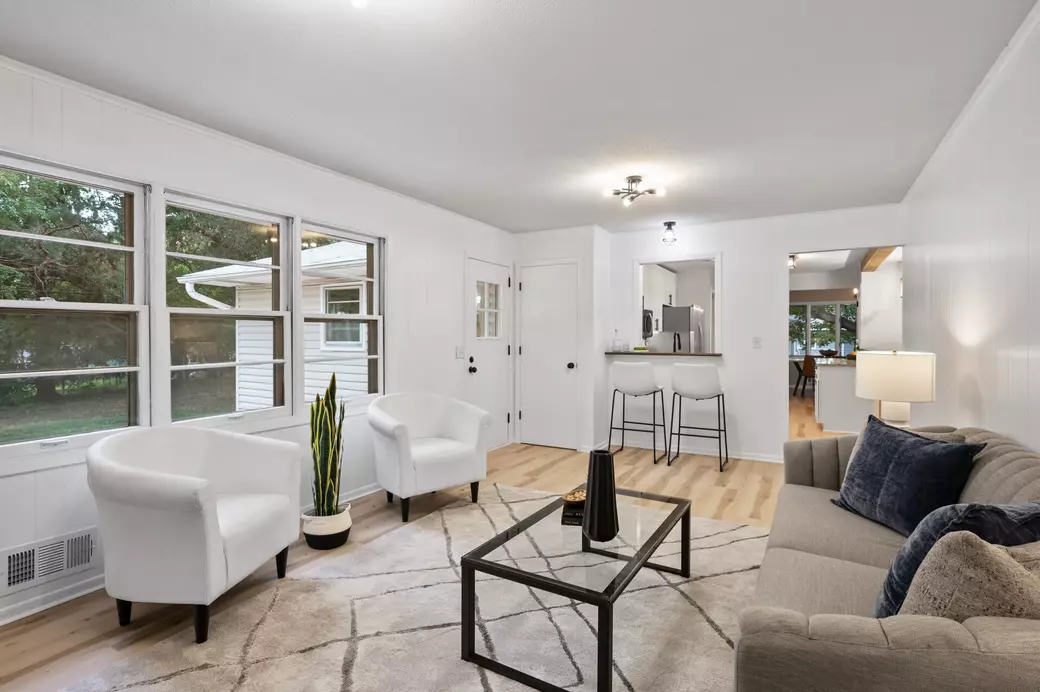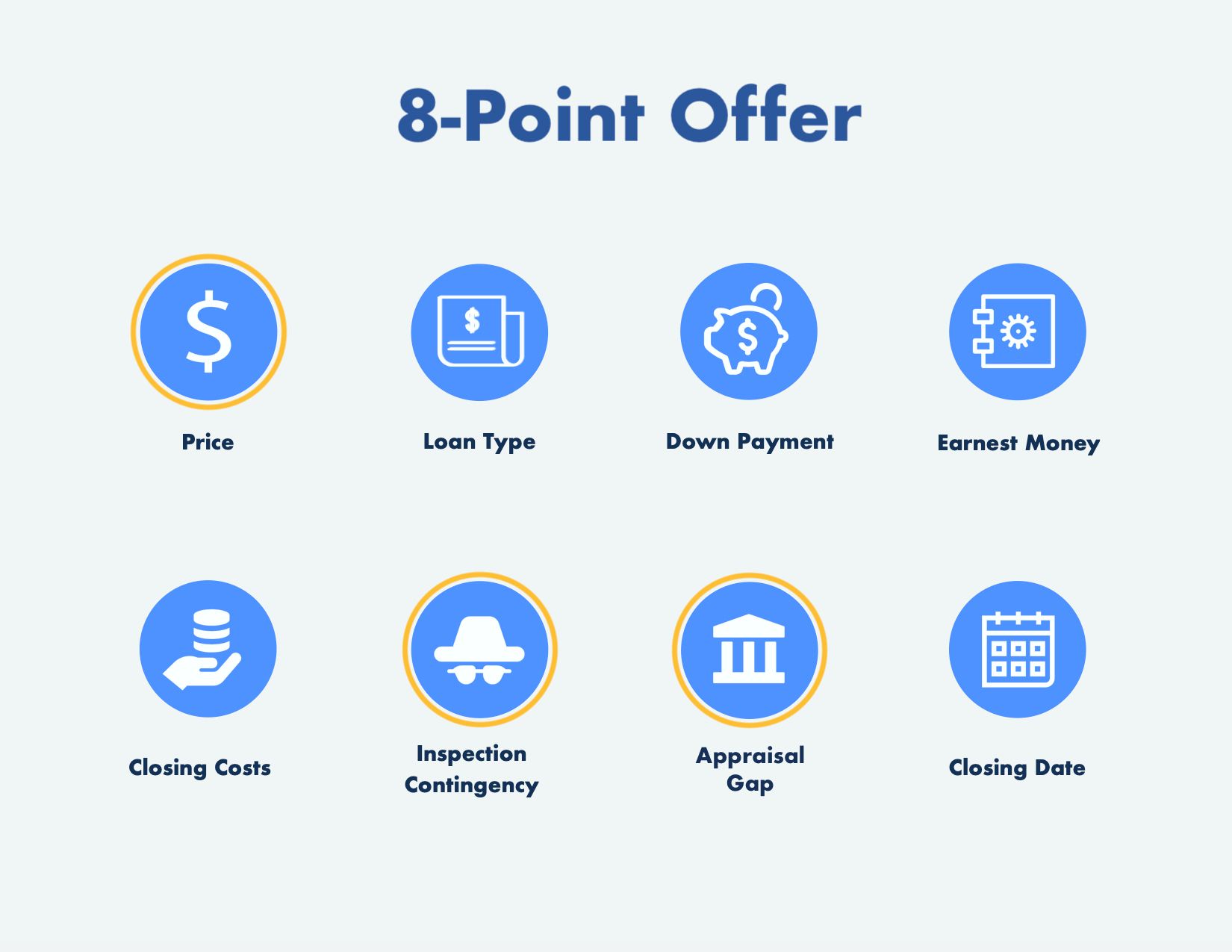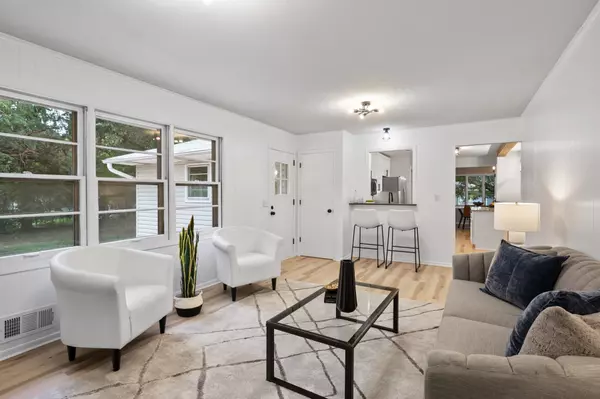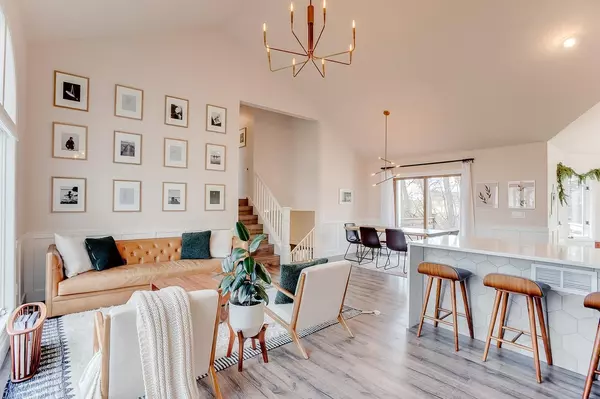How to Triple the Chances of Getting Your Offer Accepted

The “8-Point Offer”
The recipe to getting an offer accepted.
It’s a competitive market. And getting an offer accepted is hard. You already have the down payment saved…so getting an offer accepted is the last thing standing in the way between you and living in that house you’re drooling over on Zillow.
There’s 2 types of home buyers:
Type 1: Struggling buyer:
Can’t seem to get the home they want. They submit offer after offer and have no luck. The competition is too strong, and sellers are picking other buyer’s offers. They begin to wonder if this is a sign from God that they shouldn’t buy a home right now. The “market” is beginning to seem more and more suspect. Maybe it’s not a good time…
Type 2: The Savvy buyer:
These people are posing in front of their new house with a sold sign posting on instagram, “We did a thing!”. They’re happy to have the house they wanted and it seemed so easy for them. Even in this tough market. They move in and are loving their new home.
How is this possible while I’m literally grinding and crunching numbers to buy even a half decent home? Did they have to overpay to get it? Do they have way more money than me? Did their parents help?
Here’s the catch:
Many “struggling” buyers are actually just as qualified as the savvy buyers (and sometimes more qualified). The difference? Many people are missing some key ingredients in their OFFER. It’s like trying to cook a meal without a recipe. Sometimes they’re only missing ONE or TWO ingredients on their offer that’s preventing it from getting accepted!!! But once they use the right recipe…suddenly they become a savvy buyer and are able to get the home they want. This recipe is called the “8-Point Offer”. Getting an offer accepted is never a guarantee, but with $150 and taking 1 extra hour of time you can increase your chances by double or triple. It’s the blueprint to getting your offer accepted - even in a challenging market.
Before I teach you the recipe, I want to call a spade a spade:
This recipe involves being aggressive. BUT in a very calculated way. Like an analytical investor. Investors are in the same boat as you - they need to buy properties that other people are competing on, BUT they need to make sure the numbers work otherwise it defeats the purpose of the investment. Investors are aggressive, but calculated. You can be the analytical investor. And we will use some principles that investors use to dominate the market and get your next home.
What you’re doing wrong:
When people normally think about making an “offer”, oftentimes they’re only thinking about what PRICE they’re going to offer. This oversimplified mindset is what leads to much of the pain and agony in getting an offer accepted. Certainly it would be fine if sellers didn’t have trust issues. But sellers are actually looking for 2 THINGS in an offer. They want money, and they want the money GUARANTEED. Very important. (If your parents were selling their house…they would want to make sure the buyer isn’t going to back out on them in the end either.) This is where the “8-Point Offer” comes in.
The "8-Point Offer":
There are actually 8 main points/terms that exist in an offer. The 8 point offer looks to optimize all 8 terms to build the most overall attractive offer. This makes the seller want to do business with you, instead another buyer. The 1st term is PRICE, and the other 7 terms are the guarantees. The 8-point offer is so powerful that sometimes a seller is even willing to accept a LOWER offer if the guarantees are stronger. This is where the opportunity lies.

Let’s go through each of the 8 points one by one, explain what they are, and how to optimize them for your winning offer WITHOUT taking on too much risk. (Disclaimer: some of the 8 points will already be set in stone for you. i.e. down payment amount. This is OK. It just means we need to use as many of the other points as we can to compensate.) We will also focus on the “Holy Trinity” of the 8-point offer. (the 3 most important ones).
1. PRICE (Holy Trinity member #1)
Let’s get this out of the way. No seller is looking to give away their most valuable asset for a discount. EVERY seller is looking to CASH IN as much as they possibly can. When we’re in a competitive housing market, we have to offer a competitive price. This is unavoidable. The hard part is knowing HOW MUCH to offer. We don’t want to overpay for the home, but we also don’t want to lose the home to another buyer (especially if we would have been willing to pay the same thing as them!) So how do we pick the right price to offer? The number of offers on the table is a huge clue. If there are a lot of offers it means it’s a desirable home, it’s priced below its true market value, and everyone is offering their best. We need to do the same.
1st step: Figure out your top number
Work with your mortgage lender to privately figure out the MOST you’re willing to pay for the home. Use the monthly payment as your guide and work backwards to figure out what price you’re ok with.
2nd step: Use an “escalation clause”
This is where I recommend using one of my favorite techniques available to us. Let’s say you’re willing to pay $50k above list price if you HAD to. We write an offer for listing price with an “escalation clause” up to $50k above. This means our offer is a sliding scale and will automatically increase to $1000 more than any competing offer but CAPS at a max of $50k above list price. This allows you to protect yourself from getting marginally outbid, but also from paying far above the next highest offer when you don’t need to. If you still lose the bid, bummer. But you can rest easy knowing you would have had to offer something you weren’t comfortable with. If you win the bid, you’re pumped because you know you ran the numbers beforehand! The escalation clause is lethal, especially when we combine it with the other 7 tactics.
2. LOAN TYPE
There are 2 main types of loans buyers are normally using to finance a home. And sellers highly prefer one of them over the other.
1. Conventional (preferred)
2. FHA (not preferred)
If you’re offering on a home that has multiple offers, FHA offers are sadly the first to get thrown out oftentimes. Even if your price is comparable. Why? FHA loans are a fantastic program to help buyers, but they’re a government program. And in order to use this program, the government requires that homes pass stricter appraisal conditions to get final approval. Sellers don’t like this because there’s a higher risk the buyer’s financing could potentially get denied if their property doesn’t pass the appraisal. Aka, it’s less of a GUARANTEE. If this happens, it’s a HUGE gut punch for a seller because they have to put their home back on the market and start the process all over again. When given the choice, a seller would prefer to accept an offer using conventional financing. It’s more of a guarantee for them.
Note: Most times there aren’t ANY issues with an FHA loan. But SOMETIMES FHA will deny financing for certain properties. And sellers and their realtors know this. This doesn’t mean all hope is lost if you’re only approved for an FHA loan. But it does mean we’ll probably need to change your house hunting strategy to target homes that aren’t in a bidding war.
If you ARE approved for a conventional loan…CHECK. You’re stacking your arsenal with major tools to help you get an offer accepted. Let’s keep moving.
3. DOWN PAYMENT AMOUNT
Believe it or not, the amount you plan to put down can impact the attractiveness of your offer. You may be wondering…why does a seller care if I’m putting 5% down or 10% or 20% if I’m paying them the same price either way? Many sellers won’t care about this. But if given the chance, their realtor will recommend they take an offer with a higher down payment if all else is the same.
The reason comes down to this. It feels safer to work with a buyer who is flushed with cash than someone who has just enough to cover things. Where this could affect the seller is during the inspection for example. If the inspector finds the water heater is old for example, a 5% down buyer may not have an extra $3000 laying around to replace this. And they may no longer feel comfortable buying the house and want to back out. With this leverage, they may ask the seller to replace the water heater or help pay for it to keep the buyer on board. Ouch for the seller. On the other hand, if a 20% down buyer gets the same news, they might not put up a fuss at all. They might even say, “No problem, we were expecting a few things to be wrong. We have the cash to cover that and we still love the home.” A larger down payment feels like another layer of a “guarantee” for the seller. So it helps.
The Good News:
If you are a 5% down buyer for example…that’s OK. This is why the 8-point offer exists: to help get your offer accepted against other people who may be more qualified than you. We just need to lean hard into the other 7 points to compensate for the weaknesses we might have in our offer. The majority of my clients who’ve got offers accepted using the 8-point offer were not 20% down buyers. It has worked for them, and it can work for you. If you DO have 20% to put down..congratulations you are slowly becoming the best offer on the table and may have your pick of any home on the market that you want.
BONUS PRO TIP:
If you personally possess enough cash assets to put down 20% BUT you’d prefer to do less and hang on to some cash for other things…I like to still write the offer as 20% down (for the optics). The amount we write on the offer is NOT iron clad and your actual down payment can be changed to the exact dollar/penny you want at any time with your lender. If you truly ARE a safe, financially secure buyer (which is what sellers are looking for) there’s no need for you to be penalized for wanting to leverage more debt and use a smaller down payment. So I like to use the down payment section on the offer as a signal to the seller that we are a financially strong buyer. P.s. we are not agreeing to jack squat about being nice to the sellers during the inspection or anything btw. We’re just implying that we have money and they should pick our offer.
4. EARNEST MONEY
The earnest money deposit is basically a security deposit that you are required to put down once you get an offer accepted. It’s held as collateral until you close on the home then it is refunded to you. If you have an inspection contingency and you back out within that contingency, it’s refunded to you. If you have a financing contingency (which I always recommend) and your financing gets denied, it’s refunded to you. If you skip to Mexico 1 day before closing to start a new life and you don’t fulfill the purchase agreement, the seller keeps your earnest money. This earnest money is another GUARANTEE that helps the seller feel safe that a buyer has skin in the game and won’t flake out on them before closing day.
The opportunity:
The larger the earnest money amount, the stronger the guarantee you are offering to the seller and the more attractive your offer is. The best part is it’s not actually an “expense” since it’s getting refunded to you at closing. The minimum amount required is 1% of the price of the home. But many buyers using the 8-point offer will increase the amount to $10,000 or higher because they know they are getting this refunded at closing anyways (most put it towards their down payment). The earnest money amount is another easy way to continually strengthen your offer overall and increase your chances of getting it accepted.
5. CLOSING COSTS
This one will be quick. There’s a section on the offer to negotiate for the seller to pay for YOUR closing costs out of the proceeds of the sale. This is AWESOME if you have the leverage. But in a multiple offer scenario, we do not have this leverage. Asking the seller to pay for your closing costs is undoing a lot of the work we’re doing with our 8-point offer. It’s important you have enough cash saved up to pay for your own closing costs if we want to bid on a home that lots of other people want. If you don’t have this cash and you NEED “seller paid closing costs”, we just have to adjust our house hunting strategy to exclusively homes that aren’t in a bidding war.
What are “closing costs”? In addition to your down payment, a buyer is also responsible to pay for their closing costs. Closing costs are loan fees, title fees, pre-paying some insurance and taxes as required by your lender, etc. And normally ends up costing about 3% of the price of the home in total.
Ok let’s keep talking about savvy ways to get your offer accepted.
6. INSPECTION CONTINGENCY (Holy Trinity member #2)
You’re bracing for impact. You’re waiting for me to tell you to WAIVE THE INSPECTION. Here’s my recommendation: Don’t skip an inspection when buying a home. You don’t want to buy a house with a ton of problems and get stuck in a money pit. It’s risky.
Here’s the big problem though:
When there’s multiple offers, on average 20% of the offers will waive inspection. And all it takes is one person to waive inspection to start a dominoe effect of other buyers doing the same thing to be competitive. So what do we do if we want to be competitive, but still get the home inspected? One of the most successful strategies I've found for this situation is getting the home inspected before you offer on it. This "pre-offer inspection" can absolutely transform how powerful your offers are.
Why is “no inspection” SO attractive for a seller?
An offer with an inspection contingency allows a buyer to back out and cancel the purchase for any reason they want up to 7 days later. This is a huge risk for the seller because if the buyer backs out, they have to put the house back on the market. This means doing showings all over again and the start process completely over. (Imagine your parents having to do this.) It also creates a stigma around the home when other people see it’s back on the market. Because this is such a gut punch for the seller, the buyer has tons of leverage to renegotiate the price during the inspection period, and threaten to back out if the sellers don’t agree.
The inspection period is a risk to the amount of money on the sale, and the guarantee of their sale. Remember a seller wants the money and the money guaranteed? The inspection contingency threatens both. Waiving the inspection contingency is oftentimes the most impactful guarantee you can put on an offer.
The Risks For You:
I know that we’re talking a lot about the risks from the seller’s POV, but what about the risk for the BUYER?!? Not getting an inspection at all could open you up to buying a home that turns into a money pit. If you aren't willing to take on the risk of buying a home that has some undetected problems, I wouldn't recomended using this strategy. You are never FORCED to waive an inspection on an offer at any time. But taking on more risk does increase your chances of getting an offer accepted however. And that's the dilemma at hand.
Here’s the harsh thruth:
If I had to guess…you’re wanting to buy a cute, updated home in good condition that’s affordably priced between $250-500k? Congratulations, you are like almost everyone else that wants to buy a house too! It’s not wrong to want this though. I want you to have this. But when a home like this goes on the market, it’s like throwing table scraps onto the ground to a group of hungry dogs who are all licking their chops. The competition for these homes are fierce. The inspection contingency is a spot where the more aggressive humans that live among us are willing to do what it takes to get what they want. Many times we will need to match their aggression to have a chance at one of these cute homes.
The Opportunity:
Remember the analytical investor? Aggressive but calculated. This is where the opportunity lies. Doing the leg work upfront, 1-2 extra hours of your time, to get the home inspected BEFORE we offer. If the inspection goes well, you now you have the opportunity to waive the inspection CONTINGENCY on your offer because you should have already inspected the most expensive parts of the home.
Congratulations, you now have an offer waiving inspection, but you didn’t skip the home inspection. This is how we bring that same energy as the aggressors who live among us, but we are never overextending ourselves or taking on too much risk. You almost have this house in the bag - let’s go to the next.
7. APPRAISAL GAP GUARANTEE (Holy Trinity member #3)
We’re almost done, but don’t give up yet. Because the “Appraisal Gap” is the silent killer that many buyers are using to win their house. And sometimes…the appraisal gap guarantee helps you win even if you don’t have the highest offer. Imagine waking up and seeing a home on Zillow you really wanted that sold to someone else for LESS than you offered on it. WHAT?!! How can this be?
The appraisal gap guarantee is the hardest one to understand out of all the 8-points, but can sometimes be the most powerful weapon of getting your offer accepted. It’s designed to give the seller reassurance of what will happen if the appraisal comes in low and you get denied the financing to buy the home at the price you offered. Here’s how it works.
A Seller’s Biggest Fear, Your Biggest Opportunity:
Sometimes during a home purchase, a buyer’s financing falls through. Maybe you’ve heard of this. This is WAY MORE of a gut punch to a seller than if they back out during inspection. Why? Because final loan approval happens at the very end of the process (normally 30 days or more after offer acceptance). Everyone was expecting the loan to get approved at this point. But now it’s like pulling the rug out from under both people right at the finish line. The seller has to put their home back on the market and start all over again. Maybe the seller was planning to buy their next home and was COUNTING on selling this home on time. (Again, imagine this happening to your parents.) There’s a number of things that can happen to cause this. But the most common thing is a low appraisal. To understand how to use the appraisal gap guarantee, you need to understand what the appraisal is first.
What’s an appraisal:
An appraisal is like the bank doing their own home inspection for themselves. Since the bank is giving you hundreds of thousands of dollars to buy this house, they want to make sure the house is worth what they’re loaning to you. An appraisal is required for every mortgage. They determine this appraisal value by looking at what other homes have sold for in your neighborhood recently. Here’s the catch: In a multiple offer situation where the price is getting bid up…sometimes the appraisal value can come back lower than the price you agreed to buy the home for.
Here’s an example:
Let’s say you offer $500k on a home and the seller accepts your offer. You’re now under contract with them to buy it. But the appraisal comes back at $490k. This means the bank is saying they will only give you enough financing to buy the home at $490k for this specific property. This triggers the financing contingency in your offer and protects you from being contractually obligated to still purchase the home. You’re allowed to back out and get your earnest money refunded. The seller’s worst nightmare!
They thought they were getting $500k for the home and now they’re getting nothing! Because this is such an inconvenience to the seller, the buyer’s leverage is SO strong at this point in the process. As a buyer, you have a pretty strong case to request the seller to lower their price down to the appraised value to continue with the sale. Gut punch to them. This leaves the seller with a choice: refuse to lower the price and put it back on the market, or cough up the money and just be done with it. They are in this position because the money was never guaranteed.
The “Appraisal Gap Guarantee”:
The appraisal gap guarantee is where you, as the buyer, include language in your offer about what will happen IF the appraisal comes in low later down the road. It might look something like this: “In the event that the buyer’s appraisal comes in under the agreed upon sale price, buyers agree to bring up to $7,500 in cash to satisfy any gap between the sales price and the appraised value. This total amount shall not exceed the negotiated sales price.”
This is where the appraisal gap is the silent killer. Because only buyers who have extra cash can use this. If you ONLY have enough savings to cover a minimum down payment + closing costs…then it wouldn’t be wise to pledge this money if you don’t have it. But I have had many clients who were already planning to put 10% or 20% down on the home who were totally ok with adjusting their down payment to 18% for example. Then they re-allocated some of that cash to the appraisal gap if they needed.
What are the chances the appraisal comes in low?
According to Fannie Mae, appraisals come in low less than 8% of the time. That means 92% of the time the appraisal comes in just fine, or higher. This is my experience as well. Low appraisals happen the most in the early spring because the housing market is HOT and homes are selling for top dollar, but the appraisal is comparing everything to the sales that happened over the winter where homes were selling for less. Low appraisals do happen so the possibility still exists even though it is an off chance.
Is it smart to do the appraisal gap?
People want to know if it’s smart to do this, or if they will be “losing” if they have to pay the appraisal gap. Here are two things to consider:
#1: If the appraisal comes in low, that means the bank is giving you a smaller loan. This means you’re borrowing less money. This means your monthly payment is lower. If you decide to reallocate some of your down payment money to the appraisal gap, then this usually equals everything out and your monthly payment is normally about the same in the end. Aka the same as it would have been with a larger loan and a larger down payment. No change there.
This is where it gets a little tricky to understand. Where did that cash go? It went to paying the sellers DIRECTLY instead of paying down your loan. (Remember, you don’t have 20% down anymore, you have 18% down for example.) But your monthly payment is about the same because its a smaller loan.
#2: Remember how 92% of the time the appraisal comes in totally fine? This means most times the buyer NEVER has to pay a dime! Many of the times that my clients have done an appraisal gap guarantee, it was the thing that helped them win the offer and the appraisal came back totally fine! Sellers have even accepted our offer when it wasn’t the highest simply because we had an appraisal gap. This means that the seller took a discount on the offer just to have that insurance they wouldn’t get backed out on or get negotiated down.
If you REALLY love a house, but are up against other offers with appraisal gaps and you’re really worried about doing it…have your realtor run comps in the neighborhood. If there are an abundance of strong comps, you can make a data driven decision about what to do.
8. CLOSING DATE
If the seller prefers to close on a specific date, then you can increase the attractiveness of your offer by accommodating this date. Easy!
Congrats, it’s time to write an offer on your next home!
Congratulations, you now know everything you need about getting an offer accepted in a competitive market. Using the 8-point offer strategy will require you to be aggressive, but it will help you be calculated at the same time. If you want the next home you’re dreaming of to become a reality and avoid being a struggling buyer, let's take action. Send me a message so I can help you customize an 8-point offer so we can get you the home that you want! :)



